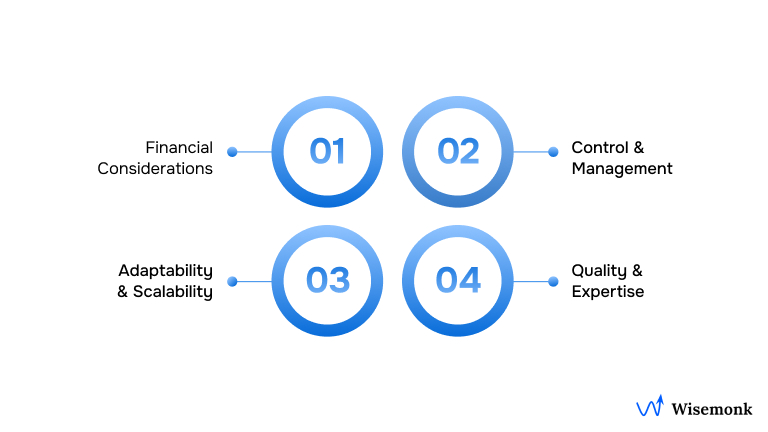- Staff augmentation is hiring external talent to temporarily fill critical skill gaps, enhance capacity, or support specific projects and initiatives without long-term commitments.
- Outsourcing is a process where a company hires third-party providers to strategically manage entire functions or projects, typically to cut costs and improve efficiency.
- The main difference is that staff augmentation adds temporary experts to your team for flexibility, while outsourcing delegates entire tasks or operations to external providers.
- Choose Staff Augmentation if you need temporary expertise and greater control over your team; Choose Outsourcing if you want to offload tasks and focus on core activities.
Not sure whether staff augmentation or outsourcing is right for you? Reach out to us today!
Discover how Wisemonk creates impactful and reliable content.
Trying to figure out whether staff augmentation or outsourcing is the right move? You’re not alone; many US companies and HR teams face the same question. Both options come with clear benefits, but choosing the best fit often depends on what your business really needs. If you’re looking to grow your team or scale operations, the choice between staff augmentation and outsourcing usually comes down to how much control, expertise, and flexibility you want along the way.
In this article, we’ll break down the differences in plain language and give you a clear picture of how each model works, so you can confidently choose the one that aligns with your business needs and growth strategy.
What is Staff Augmentation?[toc=What is Staff Augmentation]
Staff augmentation is a strategy where a company hires temporary external staff to supplement its current workforce. This helps meet increased demand, fill skill gaps, or address specific project needs. It’s a flexible approach that allows businesses to quickly scale their teams, access specialized skills without long-term commitments, and ensure smooth operations by having the right resources for critical tasks.
Key characteristics:
- Flexibility: Easily scale teams up or down based on project needs or demand.
- Specialized Expertise: Access skilled professionals with specific expertise for short-term needs.
- Temporary Support: Bring in external talent without the commitment of permanent hires.
- Operational Continuity: Ensure critical tasks are completed smoothly by supplementing your in-house team.
What is Outsourcing?[toc=What is Outsourcing]
Outsourcing is a business practice where a company hires an external third-party provider to handle tasks, processes, or functions that were once managed in-house. Companies outsource to reduce costs, access specialized skills, improve efficiency, and focus on core business activities. Examples include outsourcing customer support, IT services, manufacturing, or payroll.
Key characteristics:
- Cost Reduction: Helps lower operational costs by leveraging external resources and services.
- Access to Expertise: Provides specialized skills and knowledge not available internally.
- Focus on Core Activities: Allows businesses to concentrate on their main objectives while outsourcing non-core tasks.
- Improved Efficiency: Streamlines processes and boosts productivity by relying on experts in specific functions.
What are the differences between staff augmentation and outsourcing?[toc=Staff Augmentation vs Outsourcing]
With years of experience helping businesses scale their teams and manage talent effectively, we understand that choosing between staff augmentation and outsourcing can be a tough decision. Whether you need temporary external expertise or want to offload an entire function, knowing which approach aligns with your business goals will help you make the right choice.
Let’s break down the key differences to guide your decision.

Financial Considerations
When it comes to cost, staff augmentation typically offers more flexibility. You bring in temporary experts to work alongside your team, paying only for the specific skills and time needed for the project, no long-term benefits to worry about.
In contrast, outsourcing usually involves a fixed contract with an external provider. While this makes costs more predictable, it could also include extra fees for management or overhead.
While outsourcing may help reduce administrative overhead, staff augmentation allows you to control your budget better by paying only for the exact expertise and time required.
Control and Management
Staff augmentation gives businesses more control. Since the augmented staff work directly with your team, you can oversee day-to-day tasks, set priorities, and make adjustments as needed.
On the other hand, outsourcing hands over control of the project to the external provider. While they handle the process, this reduces your ability to directly manage operations.
Adaptability and Scalability
Staff augmentation offers greater flexibility. It lets businesses quickly scale their teams up or down depending on project needs, without being tied to long-term commitments.
In contrast, outsourcing often comes with fixed arrangements, making it harder to scale as quickly. While outsourcing offers stability, staff augmentation allows businesses to adjust their workforce size more easily.
Quality and Expertise
With staff augmentation, businesses have direct control over the quality and expertise of the professionals they bring in. You can select and integrate the right experts, ensuring the specific skill sets for the project are met.
On the other hand, outsourcing relies on the provider’s talent management and quality processes, which can limit your ability to oversee standards. While outsourcing providers may have skilled teams, their expertise may not always align perfectly with your company’s specific needs.
Now that we've covered the details, let's take a side-by-side look at the key differences between staff augmentation and outsourcing in the table below.
Now that you have a clear comparison, you can confidently decide whether staff augmentation or outsourcing is the best fit for your business needs.
What are the pros and cons of staff augmentation?[toc=Staff Augmentation: Pros & Cons]
With our experience helping businesses scale teams and manage talent needs, we’ve seen the benefits and challenges of staff augmentation firsthand. Here are the key pros and cons to consider:
Now that we've covered the pros and cons of staff augmentation, let’s explore the advantages and challenges of outsourcing.
What are the pros and cons of Outsourcing?[toc=Outsourcing: Pros & Cons]
Outsourcing streamlines business operations by transferring specific functions to external providers, enabling companies to concentrate on core competencies. However, like staff augmentation, it comes with both pros and cons. Here’s a look at them.
Now that we've outlined the pros and cons of outsourcing, you can weigh both options to make an informed decision based on your business needs.
When is Staff Augmentation the right choice?[toc=When to Augment Staff]

Staff augmentation is a strategic approach that allows businesses to supplement their teams with external professionals for specific projects or skill gaps, and with extensive experience helping companies expand globally, we’ve outlined the key scenarios when it’s the best choice.
- Filling Skill Gaps: When your organization lacks specific expertise or resources, staff augmentation allows you to bring in specialized talent temporarily.
- Scaling Quickly: During periods of increased workload or project demands, staff augmentation helps you scale your team without overburdening your core employees.
- Cost Control: This model allows companies to manage operational costs by avoiding the long-term expenses associated with full-time employees, such as salaries and benefits.
- Adapting to Market Fluctuations: In times of economic uncertainty or changing market conditions, staff augmentation provides the flexibility to adjust the workforce size as needed.
- Meeting Tight Deadlines: When fast project delivery is critical, augmented staff can help meet deadlines without the need for permanent hires.
Considering staff augmentation for your business? Explore our comprehensive article on "Top 10 Staff Augmentation Companies in India".
When is Outsourcing the best option?[toc=When to Outsource]
.png)
Outsourcing is a strategic approach that enables businesses to delegate specific tasks or functions to external experts, and with our vast experience supporting companies in their global expansion, we’ve highlighted the key situations when outsourcing is the ideal solution.
- Focus on Core Competencies: When your organization wants to concentrate on its primary business activities and leave non-core tasks to experts.
- Cost Reduction: If you need to reduce operational costs by accessing lower-cost labor markets or shared service models.
- Access to Specialized Expertise: When you require expertise that’s not available in-house and want to leverage the skills of professionals from around the world.
- Efficiency Gains: If your business needs to streamline operations and benefit from the established processes, tools, and experience of outsourcing providers.
- Scalability for Large Projects: For large-scale projects or ongoing functions that require more resources than your internal team can handle.
- Faster Time-to-Market: When you need a quicker turnaround on tasks or projects and can benefit from the outsourcing provider’s existing workflows and infrastructure.
Looking to learn more about Employment Outsourcing Services? Check out our comprehensive article on "Employment Outsourcing Services in India".
What are the real-world use cases?[toc=Real-World Use Cases]
With extensive experience helping companies expand their teams globally, here are real-world cases that highlight the effectiveness of both staff augmentation and outsourcing in various industries:
Financial Sector:
A financial institution used staff augmentation to bring in data analytics experts for a software project. This allowed them to quickly onboard new team members to bridge skill gaps and meet tight deadlines. By leveraging external talent, they enhanced their intellectual property while ensuring ongoing support for crucial business operations without the need for permanent hires.
Healthcare Industry:
A healthcare company chose IT outsourcing by partnering with a managed service provider to handle IT infrastructure and support. This decision allowed their internal team to focus on core business activities, like patient care, while outsourcing helped improve IT infrastructure and provided ongoing support, all without the investment required for in-house resources.
Software Development:
A software development firm outsourced an entire software project to a team of specialized experts. By doing so, they gained access to necessary skills, sped up the project’s completion, and ensured a high-quality product. This move helped bridge skill gaps and allowed the in-house team to focus on strategic growth initiatives.
E-commerce:
An e-commerce company utilized staff augmentation during peak sales seasons to temporarily add customer service professionals to their team. This enabled them to efficiently manage the increased workload while ensuring quality service. The flexibility of staff augmentation allowed them to maintain smooth operations and ongoing support without needing to hire full-time employees.
These examples demonstrate how staff augmentation and outsourcing can both provide strategic benefits, allowing businesses to scale their operations and adapt to changing needs with the right talent at the right time.
What are the different types of Staff Augmentation?[toc=Types of Staff Augmentation]
Based on our expertise in building global teams, here are the types of staff augmentation commonly used:
- Project-Based Augmentation: Hiring external experts for specific projects without long-term commitments.
- Onshore Staff Augmentation: Bringing in talent from within your country to minimize communication and cultural differences.
- Offshore Staff Augmentation: Hiring remote teams from other countries to save costs or provide 24/7 operations.
- Nearshore Staff Augmentation: Hiring teams from neighboring countries for easier collaboration and cost savings.
What are the different types of Outsourcing?[toc=Types of Outsourcing]
With our extensive experience in helping businesses scale globally, here’s a quick breakdown of the common types of outsourcing:
- Offshore Outsourcing: Contracting services to providers in other countries, typically for cost savings.
- Onshore Outsourcing: Hiring providers within your own country to reduce language and cultural barriers.
- Nearshore Outsourcing: Contracting service providers in nearby countries, balancing cost savings with proximity.
- BPO (Business Process Outsourcing): Outsourcing non-core processes like customer support, HR, and accounting.
- ITO (Information Technology Outsourcing): Outsourcing IT services such as software development, infrastructure, and data analytics.
Summing up[toc=Conclusion]
In summary, both staff augmentation and outsourcing offer distinct benefits, depending on your business needs. Staff augmentation provides flexibility, control, and specialized expertise for specific projects, while outsourcing offers cost-efficiency, global talent access, and operational efficiency. Choosing the right approach depends on your goals, resources, and the level of control you wish to maintain.
When outsourcing overseas, how can businesses overcome challenges like cultural differences, time zone gaps, and quality control issues? Wisemonk’s EOR service solves these problems by managing compliance, payroll, and benefits, ensuring smooth operations and scalability for global teams.
Let Wisemonk simplify your global workforce management. Contact us today to unlock effortless talent solutions and scalable growth!





.webp)

.webp)